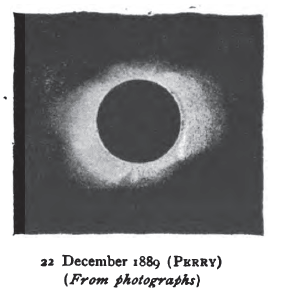Solar Eclipse Of December 22, 1889 on:
[Wikipedia]
[Google]
[Amazon]
A total

NASA graphic
*
Googlemap
*
NASA Besselian elements
Lick Observatory Plate Archive, Mt. Hamilton.
by Albert Bergman (A Man Before the Mast), New York, 1890 * * {{Solar eclipses 1889 12 22 1889 12 22 1889 in science December 1889 events
solar eclipse
A solar eclipse occurs when the Moon passes between Earth and the Sun, thereby obscuring the view of the Sun from a small part of the Earth, totally or partially. Such an alignment occurs during an eclipse season, approximately every six month ...
occurred on December 22, 1889. A solar eclipse
A solar eclipse occurs when the Moon passes between Earth and the Sun, thereby obscuring the view of the Sun from a small part of the Earth, totally or partially. Such an alignment occurs during an eclipse season, approximately every six month ...
occurs when the Moon
The Moon is Earth's only natural satellite. It is the fifth largest satellite in the Solar System and the largest and most massive relative to its parent planet, with a diameter about one-quarter that of Earth (comparable to the width of ...
passes between Earth
Earth is the third planet from the Sun and the only astronomical object known to harbor life. While large volumes of water can be found throughout the Solar System, only Earth sustains liquid surface water. About 71% of Earth's surfa ...
and the Sun, thereby totally or partly obscuring the image of the Sun for a viewer on Earth. A total solar eclipse occurs when the Moon's apparent diameter
The angular diameter, angular size, apparent diameter, or apparent size is an angular distance describing how large a sphere or circle appears from a given point of view. In the vision sciences, it is called the visual angle, and in optics, it is ...
is larger than the Sun's, blocking all direct sunlight, turning day into darkness. Totality occurs in a narrow path across Earth's surface, with the partial solar eclipse visible over a surrounding region thousands of kilometres wide.
It was visible from Cuba
Cuba ( , ), officially the Republic of Cuba ( es, República de Cuba, links=no ), is an island country comprising the island of Cuba, as well as Isla de la Juventud and several minor archipelagos. Cuba is located where the northern Caribbea ...
, to the coast of Brazil
Brazil ( pt, Brasil; ), officially the Federative Republic of Brazil (Portuguese: ), is the largest country in both South America and Latin America. At and with over 217 million people, Brazil is the world's fifth-largest country by area ...
, and across southern Africa
Africa is the world's second-largest and second-most populous continent, after Asia in both cases. At about 30.3 million km2 (11.7 million square miles) including adjacent islands, it covers 6% of Earth's total surface area ...
.
The eclipse was the focus of a scientific expedition from the United States, led by David P. Todd of Amherst College and including a team of at least six. Among the members was E. J. Loomis from the American Ephemeris and Nautical Almanac
''The American Ephemeris and Nautical Almanac'' was published for the years 1855 to 1980, containing information necessary for astronomers, surveyors, and navigators. It was based on the original British publication, '' The Nautical Almanac and Ast ...
office. It set sail October 16 on the USS Pensacola
There have been four United States Navy ships named USS ''Pensacola'':
*The first was a steamer launched in 1859 and was decommissioned in 1911.
*The second was a German steamer seized when the United States entered World War I and used as a tra ...
and set up the eclipse base camp in December, roughly 70 miles south of Luanda
Luanda () is the capital and largest city in Angola. It is Angola's primary port, and its major industrial, cultural and urban centre. Located on Angola's northern Atlantic coast, Luanda is Angola's administrative centre, its chief seaport ...
in Cape Ledo. Totality was completely obscured by cloud cover. The ship returned to New York after 242 days, with the expedition performing a variety of other scientific studies along the way.
Observations

Related eclipses
Saros 130
References
NASA graphic
*
Googlemap
*
NASA Besselian elements
Lick Observatory Plate Archive, Mt. Hamilton.
by Albert Bergman (A Man Before the Mast), New York, 1890 * * {{Solar eclipses 1889 12 22 1889 12 22 1889 in science December 1889 events